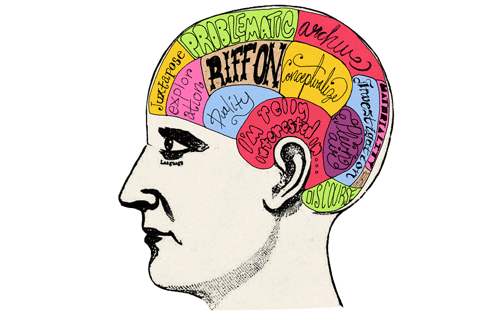May we offer some advice for your future critiques? Here a few words and phrases that one can tend towards in art speak and at SAIC in general. I’d like for you to resist using them, unless you’re sure it’s the only way to say what you need communicate.

Illustration by Jordan Whitney Martin
1) “Problematic”
We tend to use this word when there’s a problem.
“Problematic,” is often said to evoke something that is obviously troublesome for complex, yet known, reasons. Usually, these reasons are grounded in benchmark texts in cultural/race/gender theory which have helped make scholarship and (maybe) the world at large aware of systemic issues. Furthermore, when the term is employed in critical discussion, it works as a synecdoche and saves time for explaining why something is problematic. For example, blackface might not be appropriate on the contemporary stage. Saying that this is problematic assumes that everyone is on a shared plane of agreement and this can be quite practical for discussions that wish to go deeper, but don’t have time to reinvent the wheel. However, it is rarely enough to simply say that something is problematic. We need to work harder. The isolated single-word, four-syllable response is occasionally acceptable: on a hot day perhaps you’ve found your thighs have adhered themselves to the Corinthian leather in your grandmother’s LeBaron. No other word is more suitable.
2) “Archive”
There’s no pill easier to swallow than a project that never ends.
Archives are ideal for research and are often built over time. We frequently approach them as if we were building a tower. Height is added through every contribution — letters, emails, photographs, ashtrays, gum-wads, and plastic bottles. The hope is that one day the tower will be tall enough to show some type of history (though not always a linear one) and allow for a vantage point which was never before possible. The summit might bring a new insight. However, the archive requires dedication. Searching and obtaining material is an on-going effort and this must be understood before setting out on the task. The criteria for collection can change, but holding yourself accountable is the key. In critical discussions, remember that the archive is not a stopping place, unless you have an insatiable bibliographic or preservationist bent. If you make an archive, use it.
3) “…Riff On…”
Nothing is more painful.
The word “riff” is often misused. It is aurally similar to words like “rip,” “rift,” and “ruff.” Each of these homophonic words relates by definition to ideas of tension and friction between two or more parts. The vowel sounds make it easy to confuse their similar meanings and use them as substitutes for each other. Have you “ripped” on someone recently? Or rifted on a colleague lately? Be careful, you could get caught. However, if you confuse these words, few people would interrupt you, since the meaning still carries over. In the same token, “riff” can be improperly used for words that mean antagonize or mock, although in the “true” sense of the word, these definitions may actually work. To be sure, “riff” in the sense of critical dialogues often mean to reference, allude, or visibly borrow from. It’s true that few people know they’ve riffed until it’s already happened. By then it’s too late.
4) “I’m really interested in…”
Often overwhelming and revealing…
Sentences that begin to this effect often underscore something that may have already been demonstrated. Your work and ideas can sometimes hint toward a personal investment beyond class projects or collaborations. While often a useful ice-breaker, the declaration of interest can be a bit redundant, and if possible, it might be good to jump right in.
How did you arrive at your interest? Why have you stuck with it? What is the future of it?
Just sayin’.





















